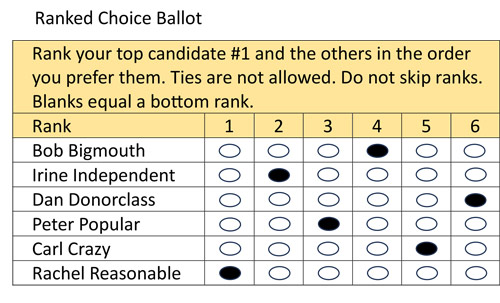Ranked Choice Voting for Single Winner Elections
Ranked Choice Voting (RCV) lets you rank every candidate. Because every voter can rank every candidate, RCV will reveal voter support for third-party and independent candidates, giving them a better chance to win.
Ranked Choice Voting (RCV), is also known as Instant Runoff Voting (IRV), Preferential Voting, Alternative Vote, and Hare. Single Transferable Vote (STV) is a version of RCV for proportional representation. Australia has used RCV (they call it Preferential Voting) for over 100 years to elect the lower chamber of parliament. The proportional upper chamber uses STV.

Simple RCV Video
Vote Counts
Votes are counted in rounds, in each round the candidate with the fewest top choice votes is eliminated. Run-off elections are unnecessary.
Round 1
We count the top choice votes on each ballot.
If a candidate has a majority (50%+1) of the votes, that candidate is elected.
If no candidate has a majority, we go to Round 2.
Additional Rounds
The candidate with the fewest top choice votes is eliminated.
Votes for the top remaining candidate from each ballot that supported the eliminated candidate are added to the vote totals of the remaining candidates.
If those votes give a candidate a majority, that candidate is elected.
If no candidate has a majority, we go to the next round.
The process is repeated until a candidate has a majority of the votes.
Key Advantages of Ranked Choice Voting
More Voice for Voters
Voters rank every candidate. You can express your opinion on all the candidates compared to each other. You can only vote “yes” for one candidate with traditional Choose One voting.
Less Negative Campaign Rhetoric
Candidates will need “second choice votes” to win RCV races with 3 or more candidates. Turning out the base is still important, but candidates also need broad support to win. In scored and ranked elections, voters can punish divisive candidates with low scores and ranks. This should calm down campaigns.
Constitutional in Most States
Many state constitutions have language that require a winning candidate to receive the “highest”, “greatest”, or “largest” number of votes, or “a plurality of the votes”. RCV complies with those state constitutions. Defenders of the status quo will litigate against any advanced voting method.
Rated voting methods like Score and Approval voting also comply because they allow every voter to cast votes to rate each candidate, the candidate with the “highest number of votes” wins.
Resistance to Strategy
Organizing a strategic campaign in an RCV election would be difficult. A winning strategy would require precise polling data. Many voters would to be organized. A mistake could hurt your candidate.
To vote strategically, individual voters would also need precise polling data. Your best bet is to rank candidates sincerely.
RCV is susceptible to the Spoiler Effect. To strategically exploit this, you could encourage someone to run who will draw votes from your chief opponent.
Imperfections
Counting the Vote
Defenders of the status quo shriek in horror because advanced voting methods are more difficult to count the Choose One. Advanced methods like RCV allow voters to say more with their vote, so there is more information to count. Australia has counted RCV and STV proportional representation ballots for years. If they can do it, we can do it.
Opponents Insult Seniors
Opponents claim that RCV is too confusing for voters, especially seniors. What is so difficult about ranking candidates?
Strategic Regret
After several RCV elections, losing parties learned they could have won with a different voting strategy. Complaints have been lodged.
By voting differently, voters could have changed the order of candidate elimination, changing the “second choice” count.
Significant Problems
Supporters of the status quo will condemn any system proposed to replace Choose 1 voting, with nary a word about its critical defects. Choose One voting has a spoiler effect problem in every election with 3 or more candidates. That said, RCV can face problems in races with 3 or more competitive candidates. The question is how often will problems occur?
Adam Graham-Squire and David McCune studied 182 RCV elections that had three or more candidates. In their report, “An Examination of Ranked Choice Voting in the United States, 2004-2022” they wrote:
“RCV mostly performs well in practice. In the American ranked-choice political elections in our database, RCV almost always selects the Condorcet winner and avoids the spoiler effect, while also demonstrating practical resistance to strategic voting. Paradoxes which feature prominently in the theoretical literature such as monotonicity and no-show paradoxes seem to occur on the order of 0.5-1.1% for real world elections without a majority candidate, and these failure rates would decrease considerably if we also included ranked-choice elections which do not advance to a second round.”
They also cautioned:
“If a failure was observed in an election for a very important office, then RCV’s overall good performance becomes less important.”
It is unclear how many of the 182 elections had three or more candidates within 15% of each other. Elections with three are more competitive candidates are difficult for RCV. If two or more candidates have similar platforms, the difficulty increases.
Not all RCV “second choice” votes are counted. The elimination order of the candidates determines which second choice votes will be counted. This can affect the outcome.
The Spoiler Effect
RCV avoids the spoiler effect in most races because voters can support multiple candidates. However, RCV races can be spoiled because the order candidates are eliminated determines which “second choice” votes are counted.
Consider this example from mingo.info. (condensed for brevity) Unfortunately, the author is not listed.
“In this election, your favorite is a popular Libertarian, a Republican is your second choice, and you dislike the Democrat. If the Libertarian has the fewest first-choice votes, he or she will be eliminated and your 2nd-choice vote will go to the Republican, as you wish.
What if the Republican is eliminated before the Libertarian? Unless all the 1st-choice Republican ballots have the Libertarian as their 2nd choice (unlikely), the Democrat might beat the Libertarian. If so, you helped the Democrat by not strategically voting for the Republican first.
By voting your true choice (Libertarian, Republican, Democrat last), you increase the chances of eliminating the Republican before the Libertarian. If that happens, your preference for the Republican over the Democrat will be ignored.”
Center Squeeze Effect
Picture a single winner, RCV election between three candidates with near equal support:
Debbie Democrat – 35%
Mike Moderate – 31%
Richard Republican – 33%
In this election, Mike Moderate is ranked second on the ballots of most Democrats because they prefer him to Richard Republican. Mike Moderate is also ranked second on the ballots of most Republicans because they prefer him to Debbie Democrat. Mike has the most overall support. Mike would beat both Debbie and Richard in one-on-one races, therefore Mike is the “beats all” or Condorcet winner.
Because Mike finishes in third place, Ranked Choice Voting would eliminate him before counting his second-choice votes on the ballots of Debbie Democrat and Richard. If Mike finished first or second in the first round of Ranked Choice Voting, he would win on the strength of those second-choice rankings.
Candidates appeal to the party base in primary elections. In a contested election, they may move towards the center. This will squeeze moderate candidates in RCV or Choose One elections. Voting methods that rate candidates like Score and Approval voting have more resistance to a center squeeze. Choose 1 voting has less resistance.
Summary
Ranked Choice Voting is superior to traditional Choose 1 voting.
RCV enables far greater voter expression than Choose 1 voting.
RCV and other advanced voting method encourage civil campaigns by rewarding candidates with broad support. Also, voters can punish divisive candidates with low ranks and scores.
RCV elections accurately report voter support of third parties and independent candidates.
RCV resists organized strategic voting campaigns and strategic voting by individual voters.
RCV complies with the constitutions of most states.
RCV does not resolve the spoiler effect in races with three or more candidates. Spoilers are more likely when two or more candidates have similar platforms.
Top Four and Final Five voting systems use RCV. Their four and five candidate runoffs create competitive elections. It was no surprise when the first Top Four election had a spoiler.
Key sources for this article:
Fair Vote is the leading advocate for Ranked Choice Voting. For more information about RCV, visit FairVote.org.
Electowiki covers RCV (they use the IRV name), at Instant Runoff Voting
The Center for Election Science is the leading proponent of Approval Voting. They make the case for Approval over RCV at https://electionscience.org/library/approval-voting-versus-irv/
An Examination of Ranked Choice Voting in the United States, 2004-2022 – Adam Graham-Squire and David McCune https://arxiv.org/pdf/2301.12075
mingo.org for the spoiler effect explanation.


